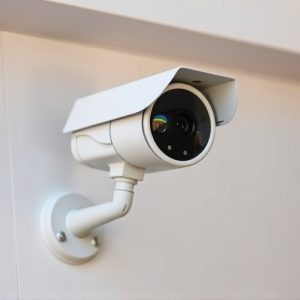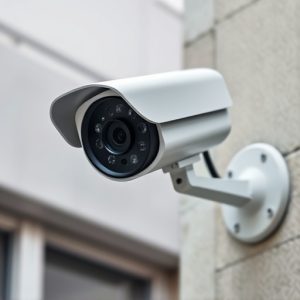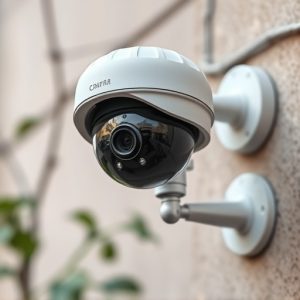Maximizing Dummy Security Camera Effectiveness: Placement, Weatherproofing, & Legal Guide
Dummy security cameras, placed at recommended heights (10-12 feet) as per guidelines, offer an affor…….
Dummy security cameras, placed at recommended heights (10-12 feet) as per guidelines, offer an affordable deterrent against intruders without power or internet. Strategically positioned at eye level, these visually striking devices provide clear surveillance footage and a psychological barrier against criminal activity. Weather-resistant housings made of stainless steel or impact-resistant plastic, along with proper testing, ensure year-round functionality. Installation considerations include optimizing field of view while avoiding sensitive areas and respecting privacy regulations by adhering to dummy security camera height guidelines.
“Uncover the power of dummy security cameras—an innovative solution for enhancing surveillance without electronic complexity. This comprehensive guide explores their multifaceted role, from deterring crime to providing peace of mind. We delve into key considerations like height guidelines (Dummy Security Camera Height Guidelines) for optimal visibility and design tips ensuring weather resistance.
Learn how these static cameras transform spaces while navigating legal and ethical aspects, making them a versatile tool for property owners and security professionals alike.”
- Understanding Dummy Security Cameras: Their Role and Benefits
- Choosing the Right Height for Optimal Visibility
- Design Considerations for Weather Resistance
- Installation Tips to Ensure Effective Surveillance
- Legal and Ethical Aspects of Deploying Dummy Cameras
Understanding Dummy Security Cameras: Their Role and Benefits
Dummy security cameras, also known as decoy or mock surveillance cameras, are an innovative solution for enhancing home and business security without the need for complex electronics. These visually striking devices serve as a powerful deterrent against potential intruders, misleading them to believe that your property is under constant observation. By strategically placing dummy cameras at recommended heights (typically between 10-12 feet or 3-3.7 meters), you can create the illusion of a comprehensive surveillance system without the associated costs and technical requirements.
One of the key advantages is their simplicity; these cameras require no power source, internet connection, or intricate setup, making them extremely easy to install and maintain. They are an excellent option for those seeking an affordable security solution, especially in areas where a visible deterrent is more effective than advanced technology. Dummy cameras can also provide valuable time for homeowners and businesses to prepare or respond to potential threats, effectively acting as a psychological barrier against criminal activity.
Choosing the Right Height for Optimal Visibility
When selecting a dummy security camera, one of the critical factors to consider is its height for optimal visibility. The ideal placement can significantly enhance the camera’s effectiveness in deterring potential intruders and providing clear surveillance footage. As a general guideline, positioning your dummy camera at eye level or slightly elevated is recommended. This strategic location allows for a broader field of view, ensuring that most areas are covered without blind spots.
The Dummy Security Camera Height Guidelines suggest maintaining a height between 5 to 7 feet (approximately 1.5 to 2.1 meters) above the ground. This range offers a balance between capturing detailed images and maintaining realism. Cameras placed too low may fail to deter criminals, while those mounted too high might not capture close-up footage of faces or license plates. By adhering to these guidelines, you can maximize the visual impact and functionality of your security camera system without relying on electronic components.
Design Considerations for Weather Resistance
When designing a security camera housing for outdoor use, weather resistance is paramount. The housing should be crafted from robust materials like stainless steel or impact-resistant plastic to withstand varying climates. Sealing all openings and gaps with gaskets or O-rings prevents water intrusion, ensuring the internal components remain dry and functional. Consider the Dummy Security Camera Height Guidelines to position the camera at optimal angles for clear visuals while protecting it from direct exposure to harsh weather conditions.
Additionally, incorporating features like a weatherproof power supply and protective lens covers can further enhance the housing’s resilience. Regular testing in simulated environmental conditions, such as rain, snow, and extreme temperatures, helps ensure the housing meets or exceeds industry standards for weather resistance. This ensures the camera remains operational and provides reliable surveillance year-round.
Installation Tips to Ensure Effective Surveillance
When installing a security camera housing without electronics, paying attention to height and placement is crucial for effective surveillance. The optimal Dummy Security Camera Height is typically eye-level or slightly higher, ensuring a clear line of sight without obstructions. This position allows for wide coverage and minimal blind spots, making it easier to monitor potential threats or unusual activities.
To ensure the best results, consider surrounding factors such as trees, signs, or other physical structures that might block the camera’s view. Avoid placing the camera too close to windows or doors, where it could be easily tampered with. Additionally, think about foot traffic patterns and the camera’s field of view—it should capture a comprehensive view without capturing sensitive areas like personal spaces or irrelevant details that could distract from security monitoring.
Legal and Ethical Aspects of Deploying Dummy Cameras
Deploying dummy security cameras, also known as decoy or fake cameras, can raise legal and ethical considerations that must be addressed to ensure compliance and maintain public trust. While they serve as a deterrent to potential criminals, their placement and use are subject to specific regulations and guidelines. For instance, in many jurisdictions, there are strict rules regarding the visible presence of surveillance equipment to protect citizens’ privacy rights. This includes specifications for dummy camera height, angle, and positioning to prevent misleading or false surveillance claims.
Ethical implications also come into play, particularly concerning the potential for deception and the psychological impact on communities. Dummy cameras should be used responsibly, with transparent disclosure when they are in operation and clear instructions on their limitations. Adhering to these guidelines ensures that the use of dummy security cameras remains a legitimate tool for enhancing safety while respecting individual freedoms and maintaining the integrity of surveillance practices.
A dummy security camera, devoid of electronics, serves as an effective deterrent without the associated costs and legal considerations of active surveillance. By strategically placing these cameras at optimal heights, as guided by our Dummy Security Camera Height Guidelines, you can enhance visibility and create a sense of safety in any environment. When properly designed for weather resistance and installed with careful consideration, dummy cameras offer a cost-efficient solution for enhancing security without compromising privacy. Remember, understanding the legal and ethical aspects is crucial when deploying these devices to ensure a secure and responsible approach to surveillance.


